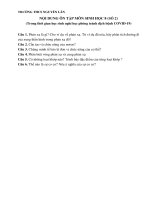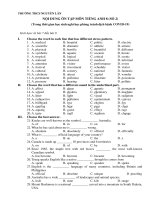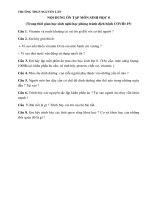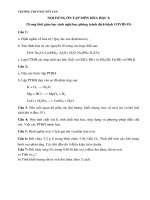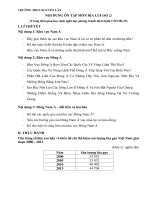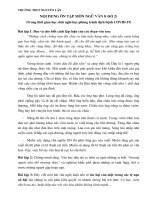- Trang chủ >>
- Sinh học >>
- Sinh học lớp 11
Nội dung ôn tập các môn khối 8 tuần 10
Bạn đang xem bản rút gọn của tài liệu. Xem và tải ngay bản đầy đủ của tài liệu tại đây (255.5 KB, 7 trang )
<span class='text_page_counter'>(1)</span><div class='page_container' data-page=1>
<b>TRƯỜNG THCS YÊN THƯỜNG </b>
<b>NĂM HỌC 2019 - 2020 </b>
<b>NỘI DUNG ƠN TẬP KHỐI 8 </b>
<b>KÌ NGHỈ DỊCH COVID-19 </b>
<i><b> (Tuần 10: Từ 6/4 đến 11/4) </b></i>
<b> </b>
<b>MƠN TỐN </b>
<b>A) Lý thuyết: </b>
<b>*Đạisố: HS học thuộc các bước giải bài toán bằng cách lập phương trình </b>
<b>*Hìnhhọc: Học sinh nắm chắc khái niệm hai tam giác đồng dạng </b>
<b>B)Bài tập: </b>
<b>I. Bài tập SGK: </b>
<b>*Đại số: Làmbài 37,38,39 /Trang 30 </b>
<b>*Hìnhhọc: Làm từ bài 23 đến bài 28/ Trang 71,72 </b>
<b>II. Bài tập bổ trợ: </b>
<i><b>1) Bài tâp về hai tam giác đờng dạng </b></i>
<i><b>Bài 1. Tam giác ABC có AB = 3cm, BC = 5cm, CA= 7cm. Tam giác A'B'C' đờng </b></i>
dạng với tam giác ABC có cạnh nhỏ nhất là 4,5cm.Tính các cạnh cịn lại của tam
giác A'B'C'.
<i><b>Bài 2. Cho tam giác ABC có AB = 16,2cm, BC = 24,3cm, AC = 32,7cm. Tính độ </b></i>
dài các cạnh của tam giác A'B'C', biết rằng tam giác A'B'C đồng dạng với tam giác
ABC và:
a. A'B' lớn hơn cạnh AB là 10,8cm.
b. A'B' bé hơn cạnh AB là 5,4cm.
<i><b>Bài 3. Cho Δ ABC ∼ Δ A'B'C' như hình vẽ. Tính tỉ số đờng dạng ? </b></i>
</div>
<span class='text_page_counter'>(2)</span><div class='page_container' data-page=2>
<i><b>2) BÀI TẬP GIẢI BÀI TOÁN BẰNG CÁCH LẬP PT </b></i>
<i><b> TỐN VỀ CHỦN ĐỢNG </b></i>
<b>Bài 1: Một xe ô tô đi từ A đến B với vận tốc 50km/h và sau đó quay trở về với vận </b>
tốc 40km/h. Cả đi và về mất 3h24 phút. Tính chiều dài quãng đường AB?
<b>Bài 2: Hai xe khởi hành cùng một lút đi tới hai địa điểm A và B cách nhau 70km </b>
và sau 1 giờ thì gặp nhau. Tính vận tốc của mỗi xe biết vận tốc xe đi từ A lớn hơn
vận tốc xe đi từ B là 10km/h.
<b>Bài 3: Hai xe gắn máy cùng khởi hành từ A đến B. Vận tốc xe thứ nhất là 45 km/h, </b>
vận tốc xe thứ hai ít hơn vận tốc xe thứ nhất 9 km/h, nên xe thứ hai đến B chậm
hơn xe thứ nhất 40 phút. Tìm khoảng cách AB.
<b>Bài 4 Một ô tô chạy trên quãng đường AB. Lúc đi ô tô chạy với vận tốc 35km/h, </b>
lúc về ô tô chạy với vận tốc 42 km/h nên thời gian về ít hơn thời gian đi là 30 phút.
Tính độ dài quãng đường AB?
</div>
<span class='text_page_counter'>(3)</span><div class='page_container' data-page=3>
<b> MÔN NGỮ VĂN</b>
<b>Bài 1: Đọc đoạn văn bản sau và trả lời câu hỏi: </b>
Chùa Một Cột nằm ở trung tâm quận Ba Đình, phía bên phải lăng Bác, trên
một con phố nhỏ cùng tên: phố Chùa Một Cột. Xét về tổng thể, chùa như một bông
sen mọc lên trong lịng một cái hờ nhỏ. Ngay chính giữa lịng hờ, người ta xây một
trụ đá lớn, đường kính 1,2m nhô lên cao khỏi mặt nước 4m. Ở trên khối đá lớn này
là hệ thống các thanh giằng, xà đỡ chắc chắn cho một mặt bằng hình vng mỗi
chiều dài 3m. Trên là một tòa lầu nhỏ, kiến trúc cổ mái cong. Ở trong tòa lầu,
người ta thờ Phật Bà Quan Âm. Để vào được chùa phải đi ngang qua một chiếc cầu
thang bằng đá xây từ mép hồ. Trên cửa có đề ba chữ “ Liên hoa đài”. Đây là tên
đúng của chùa. Tuy vậy, chúng ta thường gọi đó là chùa Một Cột – đơn giản và
thân thuộc.
<b>Câu 1: Em hãy xác định đối tượng được thuyết minh trong văn bản trên. </b>
<b>Câu 2: Đối tượng được thuyết minh theo trình tự nào? </b>
<b>Câu 3: Xác định các phương pháp thuyết minh được dùng trong văn bản trên. </b>
<b>Bài 2: Em hãy học thuộc lòng bài thơ “ Ngắm trăng” của Chủ tịch Hồ Chí </b>
<b>Minh và thực hiện các yêu cầu sau: </b>
<b>Câu 1: Chép lại chính xác bài “ Ngắm trăng” của Chủ tịch Hờ Chí Minh. Nêu </b>
hồn cảnh ra đời của bài thơ.
<b>Câu 2: Ở bài thơ này, Bác Hờ ngắm trăng trong hồn cảnh như thế nào? Qua </b>
hai câu đầu, em thấy Bác có tâm trạng ra sao trước cảnh trăng đẹp?
<b>Câu 3: Em hãy chỉ ra những biện pháp nghệ thuật được sử dụng trong hai câu </b>
thơ cuối bài và phân tích ngắn gọn tác dụng của những biện pháp nghệ thuật ấy
trong việc thể hiện nội dung câu thơ?
<b>Câu 4: Viết đoạn văn quy nạp khoảng 12 câu trình bày cảm nhận của em về </b>
hình ảnh Bác Hờ trong bài thơ. Trong đoạn văn em có sử dụng hợp lí câu cảm thán,
gạch chân và chỉ rõ câu cảm thán đó.
</div>
<span class='text_page_counter'>(4)</span><div class='page_container' data-page=4>
<b>MƠN TIẾNG ANH-TUẦN 10 </b>
<b>TEST FOR UNIT 8 </b>
<b>I. Choose the word whose underlined part is pronounced differently from the </b>
<b>others. </b>
1. A. camp B. language C. native D. accent
2. A. capital B. scenic C. Scotland D. iconic
3. A. increased B. provided C. haunted D. founded
4. A. loch B. schedule C. French D. chaos
5. A. brigade B. kilt C. liberty D. icon
<b>II. Choose the word whose main stress pattern is placed differently. </b>
1. A. American B. Canadian C. Australian D. Portuguese
2. A. monument B. symbolize C. attraction D. spectacle
3. A. natural B. trainee C. unique D. parade
4. A. territory B. festivity C. traditional D. geography
5. A. official B. legendary C. historic D. iconic
<b>IV. Choose the best answer A, B, C or D to complete the sentence. </b>
1. Residents from Liverpool speak English__________ a different accent.
<b>A. with </b> <b>B. as </b> <b>C. on </b> <b>D. under </b>
2. Last summer, Mike spent two weeks__________ a summer camp.
<b>A. for </b> <b>B. in </b> <b>C. on </b> <b>D. at </b>
3. The inhabitants of Scotland are called__________.
<b>A. Scotlanders </b> <b>B. Scotlish </b> <b>C. Scots </b> <b>D. Scotchs </b>
4. Her English accent is so good that she is thought of as a__________ speakers.
<b>A. natural </b> <b>B. official </b> <b>C. non-native </b> <b>D. native </b>
5. Loch Ness is a__________ in the Highlands of Scotland.
<b>A. person </b> <b>B. lake </b> <b>C. valley </b> <b>D. river </b>
6. __________ having two official languages, Canada has the third largest
English-speaking
population.
<b>A. Despite </b> <b>B. Because </b> <b>C. Due to </b> <b>D. Even though </b>
7. The Capital of Canada is__________.
<b>A. Edinburgh </b> <b>B. Ottawa </b> <b>C. Cardiff </b> <b>D. Belfast </b>
8. __________ your international summer camp going? - It’s just awesome.
<b>A. How’s </b> <b>B. What’s </b> <b>C. Where’s </b> <b>D. When’s </b>
9. Susan looks forward__________ a music camp, where she can sing and dance.
<b>A. to attend </b> <b>B. to attending </b> <b>C. to be attended </b> <b>D. be attending </b>
10. Where do Maoris live?
</div>
<span class='text_page_counter'>(5)</span><div class='page_container' data-page=5>
<b>V. Choose the underlined word or phrase, A, B, c or D that needs correcting. </b>
1. Could you meet us at the airport tomorrow afternoon? Our flight will land at 4
o’clock.
A B C
D
2. Australia is home of many unique species of animals that cannot be found
anywhere else.
A B C
<b>D </b>
3. The English language has approximate 400 million native speakers worldwide.
A B C D
4. The United States of American is the world’s third largest country in size.
A B C D
5. About 20 percents of the world’s population speaks English as a first or second
language.
A B C D
6. Scottish kilts were traditionally wore as full length garments by Gaelic-speaking
male.
A B C D
7. The Australian flag consists a dark blue field with the Union Jack and six white
stars.
A B C D
8. I find it’s difficult to understand some of my Scottish friends because of their
accent.
A B C D
9. Niagara Falls is one of the most spectacle waterfalls in the world.
A B C D
10. Visitors to Scotland can spend endless days to explore its historic centuries-old
castles.
<b> A B C D </b>
<b>VI. Write the correct tense or form of the verbs in brackets. </b>
1. I__________ (already/ apply) for a sports summer camp in the UK.
2. Minh usually__________ (watch) movies in English and it__________ (help)
improve his English.
3. We__________ (visit) the Statue of Liberty and Ellis Island if we go to New
York.
</div>
<span class='text_page_counter'>(6)</span><div class='page_container' data-page=6>
6. English__________ (speak) as the primary language in many countries around
the world.
7. If it __________ (not rain) today we’d take a trip to Edinburgh Castle.
8. The 12th English Teaching Conference__________ (take place) on 5-12 June.
9. Since the late 1980s, the economy of Ireland__________ (grow) rapidly.
10. Everyone__________ (sleep) when the earthquake__________ (hit) the small
town two days ago.
11. Do you have difficulty__________ (understand) your Australian friends?
12. Let’s__________ (visit) medieval castles. It’s really interesting, I think.
<b>II. Read the passage carefully and do the tasks. </b>
New Zealand is located in the south-west Pacific Ocean, 1,600 kilometres
south-east of Australia. It consists of two main islands called the North Island and
the South Island and a number of small islands. The Maori - Polynesian race - were
the first people who settled in New Zealand before the year 750 A.D. The first
European, a Dutch man called Abel Tasman arrived in New Zealand in 1642. Over
a hundred year later, in 1769, Captain James Cook who belonged to the British
Royal Navy discovered Fiordland in the South of New Zealand. Then came the
navigators, sealers, whalers, explorers and miners. From 1840, New Zealand was a
British Colony. It became an independent nation in 1947.
New Zealand is as large as the United Kingdom or Japan, but it has a much
smaller population, only about 4.9 million. Most people live on the North Island
where there are two biggest cities: Wellington, the Capital City, and Auckland, the
biggest City in terms of population.
New Zealand is a beautiful country of snow-capped mountains, beaches and
waterfalls. It’s also famous for its large population of sheep. There are about 45
million sheep living in farms all over the country. New Zealand has many special
birds. The best known is the kiwi. This lightless bird is the national emblem of
New Zealand. New Zealanders call themselves “kiwis”; it’s their nicknames!
<b>A. Decide whether the following statements are true (T) or false (F). </b>
1. New Zealand is an island country in the Pacific Ocean.
2. New Zealand was first discovered by James Cook in 1642.
3. New Zealand used to be part of the United Kingdom.
4. The alternative name for a New Zealander, Kiwi, is named after a fruit.
5. The Capital of New Zealand also has the highest population.
</div>
<span class='text_page_counter'>(7)</span><div class='page_container' data-page=7>
1. Where’s New Zealand?
___________________________________________________________
2. Who were the first people to arrive in New Zealand?
___________________________________________________________
3. When did Captain James Cook arrive in New Zealand?
___________________________________________________________
4. How many people live in New Zealand?
___________________________________________________________
5. What is the national icon of New Zealand?
</div>
<!--links-->
